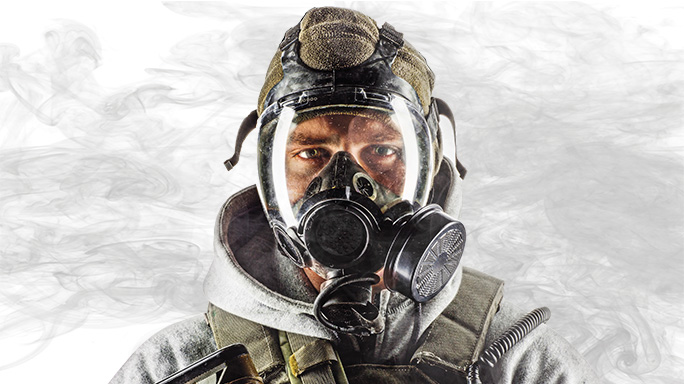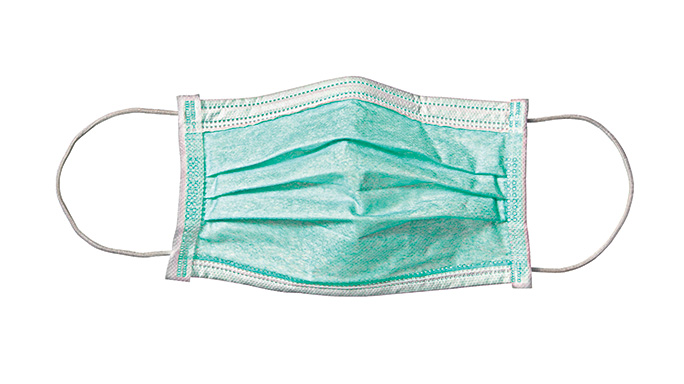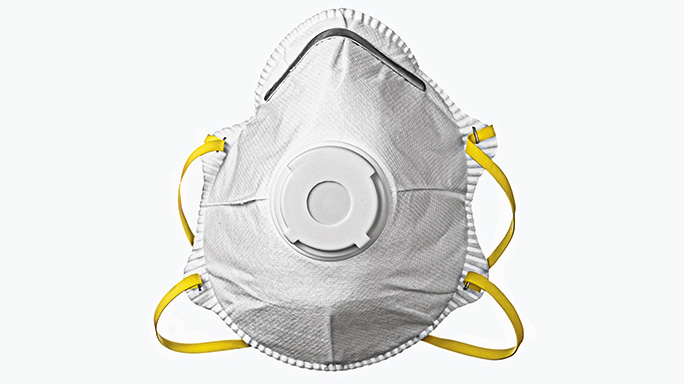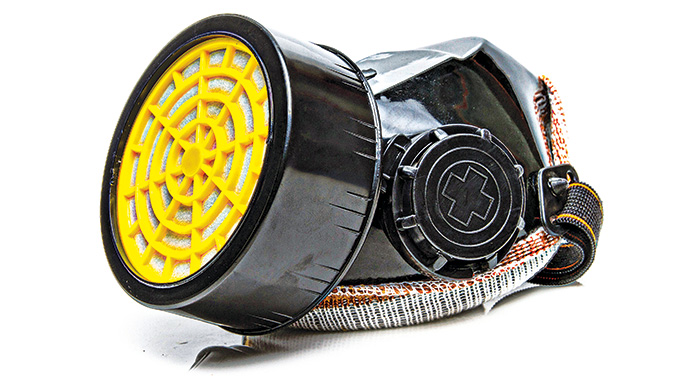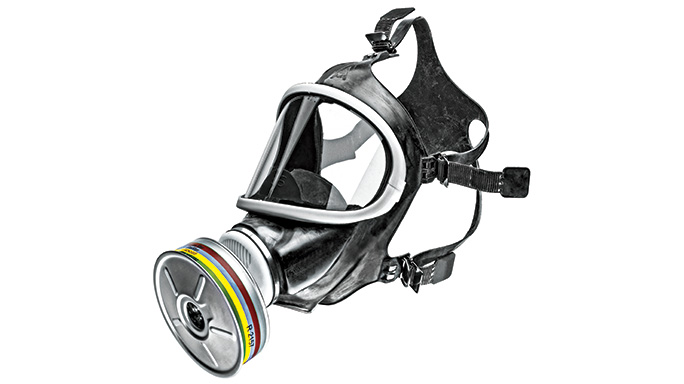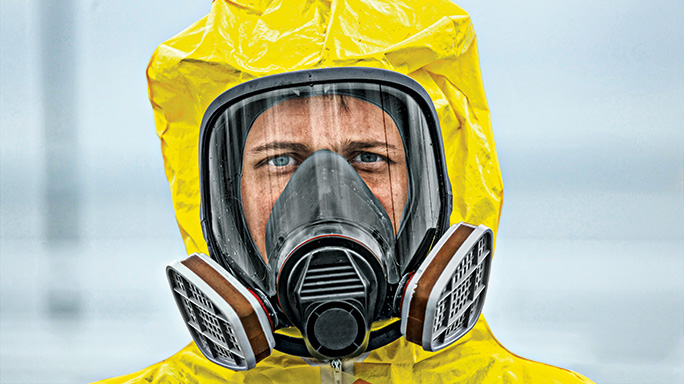Breathing is such an involuntary process that we rarely stop to think about what exactly we suck into our lungs other than the air we breathe. But just as you wouldn’t drink water from a random puddle or other questionable source, you cannot assume the air around you will be safe during times of crisis. Without air, your body will shut down within minutes, culminating in a quick death. What’s more, polluted air can carry many hazardous particles that might not have an immediate impact on your body but, over time, could propagate and lead to serious illness. When the air around you gets kind of funky, it’s wise to have safety masks or respirators around to make sure you take care of those essential airbags in your chest.
Mask It Off
Protective masks can generally be put into two categories: face masks and respirators. Face masks are the type of masks gardeners and hospital employees wear while working. They are generally made from paper or a nonwoven fabric that covers the nose and mouth. These types of masks can protect the user from larger particles such as dust and pollen, and they also provide a protective barrier from droplets of bodily fluids that might contain harmful biological bugs.
Advertisement — Continue Reading Below
Though the protection they provide is limited, face masks should be in every prepper’s storage bin since they are very cheap, disposable and easy to use. They can come in handy if one member of your party tends to have severe allergies from particles that float through the air. The most important reason to carry these facial masks is that they are effective at preventing the spread of diseases, especially when providing medical assistance to sick and infected people. These masks can protect the user from accidental splashes of blood or saliva during the administration of lifesaving medical aid.
Every Breath You Take
Respirators, on the other hand, are designed to filter most of the air you breathe by separating your mouth and nose from the outside air with a filter that separates pollutants. There are many different respirator designs as well as filter types available to the general public, and selecting the right one depends on several factors. One of the most important is fit: Proper use requires that respirators must make a complete seal with your face and not allow any gaps around the edges of the seal. Thus, it is crucial to select the correct style and shape so it is contoured to perfectly fit your face. Since we all have different facial structures, you must ensure that every member of your party gets a properly fitted respirator.
Advertisement — Continue Reading Below
The most common respirator in use is dubbed the N95. The N95 is a single-use, disposable respirator; the “N” means that it is not oil-resistant and the “95” means that it can effectively filter 95-percent of particles at the size of 0.1 to 0.3 microns. The obvious advantage of having N95 masks around is cost. Since they are relatively cheap compared to other types, stockpiling them for a large group of people will not make a huge dent in your budget. They are handy in cases of pandemics and biological threats, and great for avoiding breathing particulates that spew from collapsed buildings. However, since they can still allow 5 percent of small particles to seep through the filters, they are not bulletproof. For example, N95 respirators are not fully effective in filtering out asbestos, lead and silica particles. Another drawback to the N95 is its ineffectiveness against chemical hazards and toxic-gas vapors.
Is Your Mask Half Full?
Two other major types of respirators are half-mask and full-face respirators. As the name implies, a half mask will cover the mouth and nose while full-face respirators cover the mouth, nose and eyes, protecting your peepers from irritants. Both types of respirators are made to form a perfect seal around the face, sending the air you breathe through replaceable cartridges that will only filter out specific contaminants based on the composition of the cartridge.
Advertisement — Continue Reading Below
Full-face respirators have the advantage of protecting your eyes from chemicals as well, but this leads to a few disadvantages, such as limiting your field of vision. Both of these respirators are readily available online and in safety and protection stores and military surplus stores. Not all respirators are made equal, so be prepared to fork out a bit of money for a durable one. Anyone sporting facial hair should be aware that it will affect fit and may prevent a good seal against the skin, so a clean-shaven face might work better than the full-on chin curtain.
Once you have found a mask that fits properly, it is wise to test whether you are physically fit enough to properly breathe in one. Since breathing through a respirator requires enough lung strength to pass the outside air through filters, it can be difficult for the elderly and those with weakened lungs to get enough air to the body. It’s worth noting that the use of these respirators requires enough oxygen in the circulating air, so using one in low-oxygen environments, such as fires, will not prevent the effects of suffocation.
Gas Passers
Advertisement — Continue Reading Below
Respirators are sometimes referred to as “gas masks,” but this can be confusing, since many have particle filters that won’t help filter out toxic gases. It’s important to understand what your needs are before buying specific filter cartridges. Similar to the N95, the P100 cartridges are oil-proof (thus the “P” in the name). P100s filter out 100-percent of particles of 0.1 to 0.3 microns in size. One advantage of these two types of respirators is that they can filter harmful gas and vapors depending on the cartridge type.
These cartridges are usually made with activated charcoal or other resins that will absorb or break down specific harmful elements in the air. Know what type of cartridge your mask has, since some will work on organic vapors, others will filter out ammonia, while others still can even stop mercury vapors. For extra protection, there are combo cartridges that combine the attributes of P100-type filters with safeguards against harmful chemicals as well.
Many manufacturers use a color-coding system to designate the function of their cartridges. Though full protection from everything you may face is not possible, a full-face respirator strapped with a combination cartridge, such as the Olive/Magenta cartridge made by 3M, will limit your exposure to a wide range of nasty stuff. Because filters need to be swapped out with use, don’t forget to stockpile extra cartridges with your respirator.
Advertisement — Continue Reading Below
The Great Escape
There is one type of respirator that is designed solely for emergency purposes. The escape hood respirator doesn’t just cover the face but is placed completely over the head and wraps around the neck. It has a dedicated, filtered breathing apparatus for the mouth. These respirators are only to be used in emergencies, and for a short period of time. Specifically, they will buy a bit of extra time in case you need breathable air to escape a dangerous situation.
- RELATED STORY: Supply Drop: 7 Pieces of Cutting-Edge Gear For 2016
Once used, they are to be discarded. Having a few escape hood respirators might not be a bad idea, but you should strategically place them in different spots around your living quarters to make them easily accessible.
Advertisement — Continue Reading Below
In a rather ironic twist, the very same air that we depend on to live also has the potential to instantly end our lives. But if you plan ahead and use the correct air protection equipment, you can protect yourself from many of the invisible airborne killers
that can appear during a catastrophic event.
